Zircon LA-ICP-MS U-Pb Ages and the Hf Isotopic Composition of the Ore-Bearing Porphyry from the Yanghuidongzi Copper Deposit, Heilongjiang, China, and Its Geological Significance
Abstract
:1. Introduction
2. Geological Setting
2.1. Regional Geology
2.2. Deposit Geology
3. Sample Collection and Analysis Methods
4. Results
4.1. Zircon Morphology
4.2. Zircon U-Pb Age
4.3. Zircon Trace Element Characteristics
4.4. Zircons Hf Isotopic Composition
5. Discussion
5.1. Zircon Genesis
5.2. Metallogenic Age and Dynamics Background
5.3. Magma Source of the Ore-Bearing Porphyry
6. Conclusion
Author Contributions
Funding
Acknowledgments
Conflicts of Interest
References
- Sillitoe, R.H. Gold-Rich Porphyry Copper Deposits: Geological Model and Exploration Implications; Geological Association of Canada: St.John’s, NL, Canada, 1993; Volume 40, pp. 465–478. [Google Scholar]
- Sillitoe, R.H. Characteristics and controls of the largest porphyry copper-gold and epithermal gold deposits in the circum-Pacific region. Aust. J. Earth Sci. 1997, 44, 373–389. [Google Scholar] [CrossRef]
- Sillitoe, R.H. Porphyry copper systems. Econ. Geol. 2010, 105, 3–41. [Google Scholar] [CrossRef]
- Richards, J.P.; Boyce, A.J.; Pringle, M.S. Geologic evolution of the escondida area, Northern Chile: A model for spatial and temporal localization of porphyry Cu mineralization. Econ. Geol. 2001, 96, 271–305. [Google Scholar] [CrossRef]
- Kerrich, R.; Goldfarb, R.; Groves, D.; Garwin, S.; Jia, Y.F. The characteristics, origins and geodynamic setting of supergiant gold metallogenic provinces. Sci. China 2012, 43, 1–68. [Google Scholar] [CrossRef]
- Kay, S.M.; Mpodozis, C.; Coira, B. Neogene magmatism, tectonism, and mineral deposits of the central Andes (22° to 33° S Latitude). Soc. Econ. Geol. Spec. Publ. 1999, 7, 27–59. [Google Scholar]
- Cooke, D.R.; Wilson, A.J.; Davies, A.G.S. Characteristics and Genesis of Porphyry Copper-Gold Deposits; Centre for Ore Deposit Research Special Publication 5: Hobart, Tasmania, Australia, 2004; pp. 17–34. [Google Scholar]
- Cooke, D.R.; Hollings, P.; Walshe, J.L. Giant porphyry deposits: Characteristics, distribution, and tectonic controls. Econ. Geol. 2005, 100, 801–819. [Google Scholar] [CrossRef]
- Hou, Z.Q.; Ma, H.W.; Zaw, K.; Zhang, Y.Q.; Wang, M.J.; Wang, Z.; Pan, G.T.; Tang, R.L. The Himalayan Yulong porphyry copper belt: Product of large-scale strike-slip faulting in eastern Tibet. Econ. Geol. 2003, 98, 125–145. [Google Scholar] [CrossRef]
- Hou, Z.Q.; Gao, Y.F.; Qu, X.M.; Rui, Z.Y.; Mo, X.X. Origin of adakitic intrusives generated during Mid-Miocene east-west extension in southern Tibet. Earth Planet. Sci. Lett. 2004, 220, 139–155. [Google Scholar] [CrossRef]
- Hou, Z.Q.; Qu, X.M.; Rui, Z.Y.; Meng, X.J.; Li, Z.Q.; Beaudoin, G.; Rui, Z.Y.; Gao, Y.F.; Zaw, K. The Miocene gangdese porphyry copper belt generated during post-collisional extension in the Tibetan orogen. Ore Geol. Rev. 2009, 36, 25–51. [Google Scholar] [CrossRef]
- Hou, Z.Q.; Zhang, H.R.; Pan, X.F.; Yang, Z.M. Porphyry Cu (–Mo–Au) deposits related to melting of thickened mafic lower crust: Examples from the eastern Tethyan metallogenic domain. Ore Geol. Rev. 2011, 39, 21–45. [Google Scholar] [CrossRef]
- Qin, K.Z.; Tosdal, R.M.; Li, G.M.; Zhang, Q.; Li, J.L. Formation of the Miocene porphyry Cu (–Mo–Au) deposits in the Gangdese arc, southern Tibet, in a transitional tectonic setting. In Mineral Deposit Research: Meeting the Global Challenge; Zhao, C.C., Guo, B.J., Eds.; China land publishing House Place: Beijing, China, 2005; Volume 3, pp. 44–47. [Google Scholar]
- Ge, W.C.; Wu, F.Y.; Zhou, C.Y.; Zhang, J.H. Porphyry Cu-Mo deposits in the eastern Xing’an-Mongolian Orogenic Belt: Mineralization ages and their geodynamic implications. Chin. Sci. Bull. 2007, 52, 3416–3427. [Google Scholar] [CrossRef]
- Lee, J.; Williams, I.; Ellis, D. Pb, U and Th diffusion in nature zircon. Nature 1997, 390, 159–162. [Google Scholar] [CrossRef]
- Cherniak, D.J.; Watson, E.B. Pb diffusion in zircon. Chem. Geol. 2000, 172, 5–24. [Google Scholar] [CrossRef]
- Wu, Y.B.; Zheng, Y.F. Genesis of zircon and its constraints on interpretation of U-Pb age. Chin. Sci. Bull. 2004, 49, 1554–1569. [Google Scholar] [CrossRef]
- Patchett, P.J. Importance of the Lu-Hf isotopic system in studies of planetary chronology and chemical evolution. Geochim. Cosmochim. Acta 1983, 47, 81–91. [Google Scholar] [CrossRef]
- Wang, F.; Zhu, L.; Li, J.; Lee, B.; Gong, H.; Yang, T.; Wang, W.; Xu, A. Zircon U-Pb ages and Hf isotopic characteristics of the Dehe biotite monzonitic gneiss pluton in the North Qinling orogen and their geological significance. Chin. J. Geochim. 2011, 30, 204–216. [Google Scholar] [CrossRef]
- Wu, F.Y.; Li, X.H.; Zheng, Y.F.; Gao, S. Lu-Hf isotopic systematics and their application in petrology. Acta Petrol. Sin. 2007, 23, 185–220. (In Chinese) [Google Scholar]
- Lv, J.C. The Ore-Forming Geological Conditions and Prospecting Orientation of Yanghuidongzi Cu Deposit. Master’s Thesis, Jilin University, Changchun, China, 2014. (In Chinese). [Google Scholar]
- Zhu, J.Q.; Sun, J.G.; Men, L.J.; Gu, A.L.; Chen, Y.J.; Ming, Z.; Zhao, S.F.; Yan, J. Metallogenic mechanism of Yanghuidongzi copper deposit in eastern Heilongjiang Province: Mineralization-alteration, fluid inclusions and stable isotope tracing. Depos. Geol. 2016, 35, 365–380. (In Chinese) [Google Scholar]
- Wu, F.Y.; Sun, D.Y.; Ge, W.C.; Zhang, Y.B.; Grant, M.L.; Wilde, S.A.; Jahn, B.M. Geochronology of the Phanerozoic granitoids in northeastern China. J. Asian Earth Sci. 2011, 41, 1–31. [Google Scholar] [CrossRef]
- Zhang, B.C. Detailed Report on Yanghuidong Copper Mine in Dongning County; Heilongjiang Province Nonferrous Metals Geological Exploration 702 Team: Mudanjiang, China, 2009. (In Chinese) [Google Scholar]
- Zhao, S.; Xu, D.H.; Wang, Y.P. Regional Geological Survey Report of the People’s Republic of China 1:50,000 (L52E022020 Suiyang Town); Heilongjiang Provincial Geological Survey and Research Institute: Harbin, China, 2011. (In Chinese) [Google Scholar]
- Eggins, S.M.; Kinsley, L.P.J.; Shelley, J.M.G. Deposition and element fractionation processes during atmospheric pressure laser sampling for analysis by ICP-MS. Appl. Surf. Sci. 1998, 127–129, 278–287. [Google Scholar] [CrossRef]
- Jackson, S.E.; Pearson, N.J.; Griffin, W.L.; Belousova, E.A. The application of laser ablation-inductively coupled plasma-mass spectrometry to in situ U–Pb zircon geochronology. Chem. Geol. 2004, 211, 47–70. [Google Scholar] [CrossRef]
- Wiedenbeck, M. An example of reverse discordance during ion microprobe zircon dating: An artifact of enhanced ion yields from a radiogenic labile Pb. Chem. Geol. 1995, 125, 197–219. [Google Scholar] [CrossRef]
- Yuan, H.; Gao, S.; Liu, X.M.; Li, H.M.; Gunther, D.; Wu, F.Y. Accurate U-Pb age and trace element determinations of zircon by laser ablation-inductively coupled plasma-mass spectrometry. Geostand. Geoanal. Res. 2004, 28, 353–371. [Google Scholar] [CrossRef]
- Ludwig, K.R. Isoplot 3.0: A Geochronological Toolkit for Microsoft Excel; Berkeley Geochronology Center: Berkeley, CA, USA, 2003; p. 70. [Google Scholar]
- Wiedenbeck, M.; Alle, P.; Corfu, F.; Griffin, W.L.; Meier, M.; Oberli, F.; Quadt, A.V.; Roddick, J.C.; Spiegel, W. Three natural zircon standards for U-Th-Pb, Lu-Hf, trace element and REE analyses. Geostandard. Newslett. 1995, 19, 1–23. [Google Scholar] [CrossRef]
- Wu, F.Y.; Yang, Y.H.; Xie, L.W.; Yang, J.H.; Xu, P. Hf isotopic compositions of the standard zircons and baddeleyites used in U-Pb geochronology. Chem. Geol. 2006, 234, 105–126. [Google Scholar] [CrossRef]
- Woodhead, J.; Hergt, J.; Shelley, M.; Eggins, S.; Kemp, R. Zircon Hf-isotope analysis with an excimer laser, depth profiling, ablation of complex geometries, and concomitant age estimation. Chem. Geol. 2004, 209, 121–135. [Google Scholar] [CrossRef]
- Blicherttoft, J.; Albarède, F. The Lu-Hf isotope geochemistry of chondrites and the evolution of the mantle-crust system. Earth Planet. Sci. Lett. 1998, 154, 243–258. [Google Scholar] [CrossRef]
- Griffin, W.L.; Pearso, N.J.; Belousova, E.; Jackson, S.E.; Achterbergh, E.; O’Reilly, S.Y.; Shee, S.R. The Hf isotope composition of cratonic mantle: LAM-MC-ICPMS analysis of zircon megacrysts in kimberlites. Geochim. Cosmochim. Acta 2000, 64, 133–147. [Google Scholar] [CrossRef]
- Griffin, W.L.; Wang, X.; Jackson, S.E.; Pearson, N.J.; O’Reilly, S.Y.; Xu, X.S.; Zhou, X.M. Zircon chemistry and magma mixing, SE China: In-situ analysis of Hf isotopes, Tonglu and Pingtan igneous complexes. Lithos 2002, 61, 237–269. [Google Scholar] [CrossRef]
- Corfu, F.; Hanchar, J.M.; Hoskin, P.W.O.; Kinny, P. Atlas of zircon textures. Rev. Mineral. Geochem. 2003, 53, 469–500. [Google Scholar] [CrossRef]
- Tang, J.H.; Gu, L.X.; Zhang, Z.Z.; Wu, C.Z.; San, J.Z.; Wang, C.S.; Liu, S.H.; Zhang, G.H. Hyperplastic edge CL of hydrothermal and character- istics of REE for zircon of Xianshuiquan gneissic granite Hyperplastic edge CL of hydrothermal and character- istics of REE for zircon of Xianshuiquan gneissic granite. Prog. Nat. Sci. 2008, 18, 769–777. (In Chinese) [Google Scholar]
- McDonough, W.F.; Sun, S.-S. The composition of the Earth. Chem. Geol. 1995, 120, 223–253. [Google Scholar] [CrossRef]
- Curtis, C.E.; Sowman, H.G. Investigation of the Thermal Dissociation, Reassociation, and Synthesis of Zircon. J. Am. Ceram. Soc. 1953, 36, 190–198. [Google Scholar] [CrossRef]
- Sawka, W.N. REE and trace element variations in accessory minerals and hornblende from the strongly zoned McMurry Meadows Pluton, California. Earth Sci. 1988, 79, 157–168. [Google Scholar] [CrossRef]
- Bea, F. Residence of REE, Y, Th and U in granites and crustal protoliths, implications for the chemistry of crustal melts. J. Petrol. 1996, 97, 521–552. [Google Scholar] [CrossRef]
- O’Hara, M.J.; Fry, N.; Prichard, H.M. Minor phase as carriers of trace elements in non-modal crystal-liquid separation processes I: Basic relationships. J. Petrol. 2001, 42, 1869–1885. [Google Scholar] [CrossRef]
- Hoskin, P.W.O. Trace-element composition of hydrothermal zircon and the alteration of Hadean zircon from the Jack Hills, Australia. Geochim. Cosmochim. Acta 2005, 69, 637–648. [Google Scholar] [CrossRef]
- Fu, B.; Mernagh, T.P.; Kita, N.T.; Kemp, A.I.S.; Valley, J.W. Distinguishing magmatic zircon from hydrothermal zircon: A case study from the Gidginbung high-sulphidation Au–Ag–(Cu) deposit, SE Australia. Chem. Geol. 2009, 259, 131–142. [Google Scholar] [CrossRef]
- Xu, W.L.; Wang, F.; Pei, F.P.; Meng, E.; Tang, J.; Xu, M.J.; Wang, W. Mesozoic tectonic regimes and regional ore-forming background in NE China: Constraints from spatial and temporal variations of Mesozoic volcanic rock associations. Acta Petrol. Sin. 2013, 29, 339–353. (In Chinese) [Google Scholar]
- Wang, T.; Zheng, Y.D.; Zhang, J.J.; Zeng, L.S.; Donskaya, T.V.; Guo, L.; Li, J.B. Pattern and kinematic polarity of late Mesozoic extension in continental NE Asia: Perspectives from metamorphic core complexes. Tectonics 2011, 30, TC6007. [Google Scholar] [CrossRef]
- Wang, T.; Guo, L.; Zheng, Y.D.; Donskaya, T.; Gladkochub, D.; Zeng, L.S.; Li, J.B.; Wang, Y.B.; Mazukabov, A. Timing and processes of late Mesozoic mid-lower-crustal extension in continental NE Asia and implications for the tectonic setting of the destruction of the North China Craton: Mainly constrained by zircon U–Pb ages from metamorphic core complexes. Lithos 2012, 154, 315–345. [Google Scholar] [CrossRef]
- Li, J.Y. Permian geodynamic setting of Northeast China and adjacent regions: Closure of the Paleo-Asian Ocean and subduction of the Paleo-Pacific Plate. J. Asian Earth Sci. 2006, 26, 207–224. [Google Scholar] [CrossRef]
- Xiao, W.J.; Windley, B.F.; Huang, B.C.; Han, C.M.; Yuan, C.; Chen, H.L.; Sun, M.; Sun, S.; Li, J.L. End Permian to mid-Triassic termination of the southern Central Asian Orogenic Belt. Int. J. Earth Sci. 2009, 98, 1189–1217. [Google Scholar] [CrossRef]
- Cao, H.H.; Xu, W.L.; Pei, F.P.; Wang, Z.W.; Wang, F.; Wang, Z.J. Zircon U-Pb geochronology and petrogenesis of the Late Paleozoic-Early Mesozoic intrusive rocks in the eastern segment of the northern margin of the North China Block. Lithos 2013, 170–171, 191–207. [Google Scholar] [CrossRef]
- Xu, W.L.; Pei, F.P.; Wang, F.; Meng, E.; Ji, W.Q.; Yang, D.B.; Wang, W. Spatial–temporal relationships of Mesozoic volcanic rocks in NE China: Constraints on tectonic overprinting and transformations between multiple tectonic regimes. J. Asian Earth Sci. 2013, 74, 167–193. [Google Scholar] [CrossRef]
- Zhang, J.H.; Ge, W.C.; Wu, F.Y.; Wilde, S.A.; Yang, J.H.; Liu, X.M. Large-scale Early Cretaceous volcanic events in the northern Great Xing’an Range, northeastern China. Lithos 2008, 102, 138–157. [Google Scholar] [CrossRef]
- Hoffmann, J.E.; Münker, C.; NaRaa, T.; Rossing, M.T.; Herwartz, D.H.; Schönberg, D.G.; Svahnberg, H. Mechanisms of Archean crust formation inferred from high-precision HFSE systematics in TTGs. Geochim. Cosmochim. Acta 2011, 75, 4157–4178. [Google Scholar] [CrossRef]
- Rundnick, R.L.; Gao, S. Composition of the continental crust. In Treatise on Geochemistry; Holland, H.D., Turekian, K., Eds.; Elsevier: Amsterdam, The Netherlands, 2004; Volume 3, pp. 1–64. [Google Scholar]
- Munker, C. Evolution of Planetary Cores and the Earth-Moon System from Nb/Ta Systematics. Science 2003, 301, 84–87. [Google Scholar] [CrossRef]
- Jahn, B.M.; Wu, F.Y.; Chen, B. Granitoids of the Central Asian Orogenic Belt and continental growth in the Phanerozoic. R. Soc. Edinb. 2000, 91, 181–193. [Google Scholar] [CrossRef]
- Wu, F.Y.; Jahn, B.M.; Wilde, S.; Sun, D.Y. Phanerozoic crustal growth: U-Pb and Sr-Nd isotopic evidence from the granite in northeastern China. Tectonophysics 2000, 328, 89–113. [Google Scholar] [CrossRef]
- Yang, J.H.; Wu, F.Y.; Shao, J.A.; Wilde, S.A.; Xie, L.W.; Liu, X.M. Constraints on the timing of uplift of the Yanshan Fold and Thrust Belt, North China. Earth Planet. Sci. Lett. 2006, 246, 336–352. [Google Scholar] [CrossRef]
- Ji, Z.; Ge, W.C.; Wang, Q.H.; Hao, Y.; Guo, C.Z.; Jun, H.B.; Yu, D. Petrogenesis of Early Cretaceous volcanic rocks of the Manketouebo Formation in the Wuchagou region, central Great Xing’an Range, NE China, and tectonic implications: Geochronological, geochemical, and Hf isotopic evidence. Int. Geol. Rev. 2015, 58, 556–573. [Google Scholar] [CrossRef]
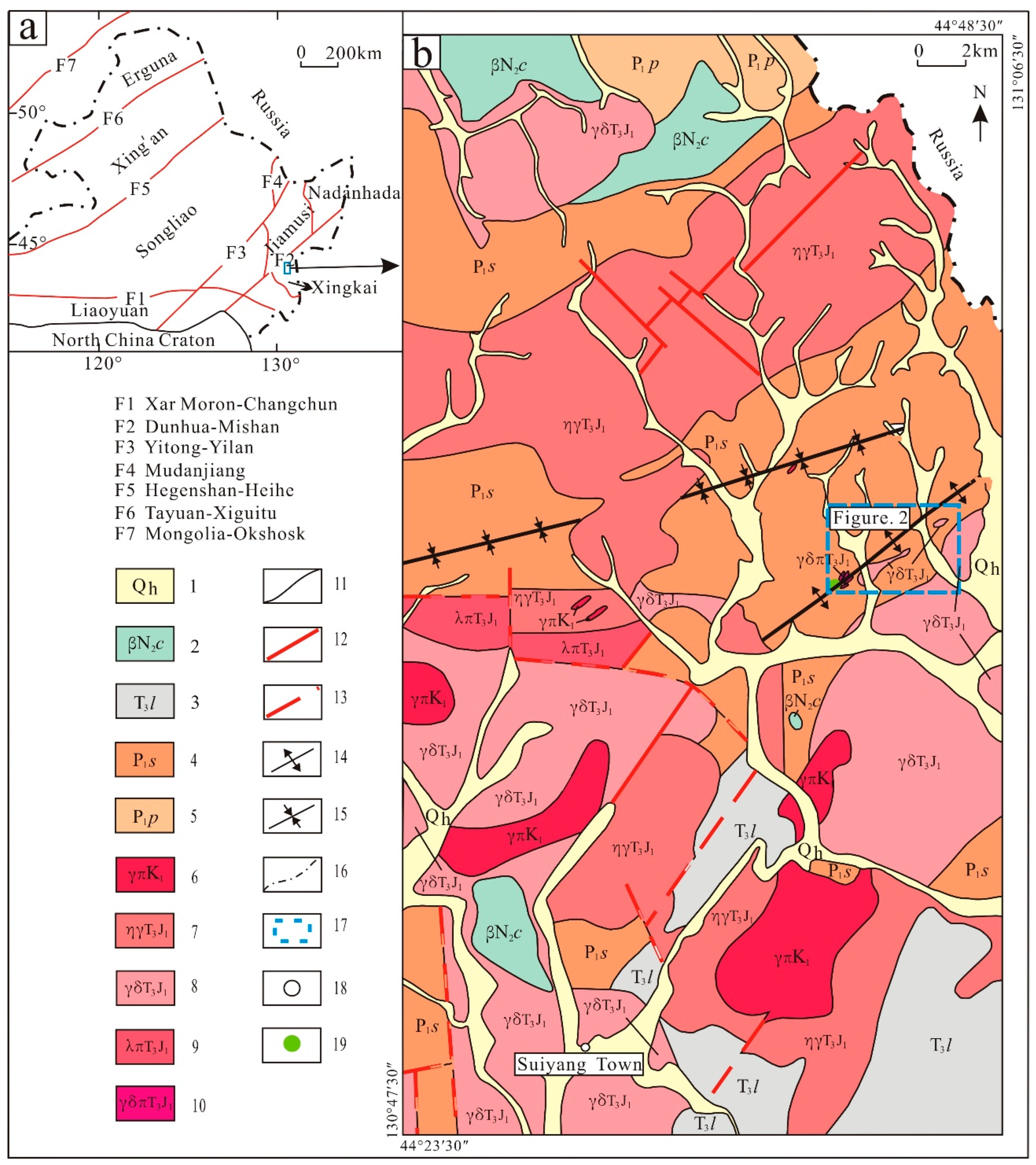
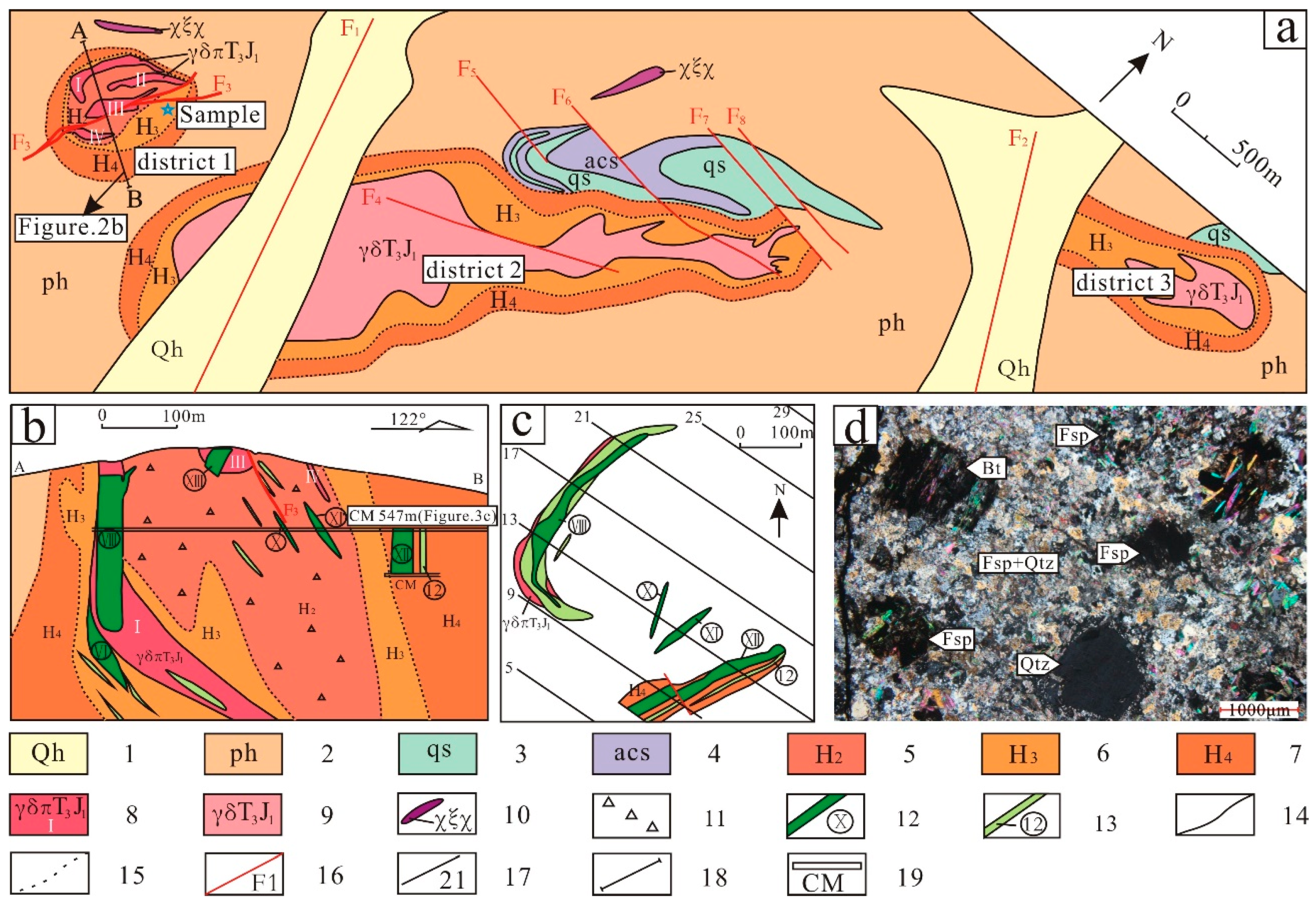

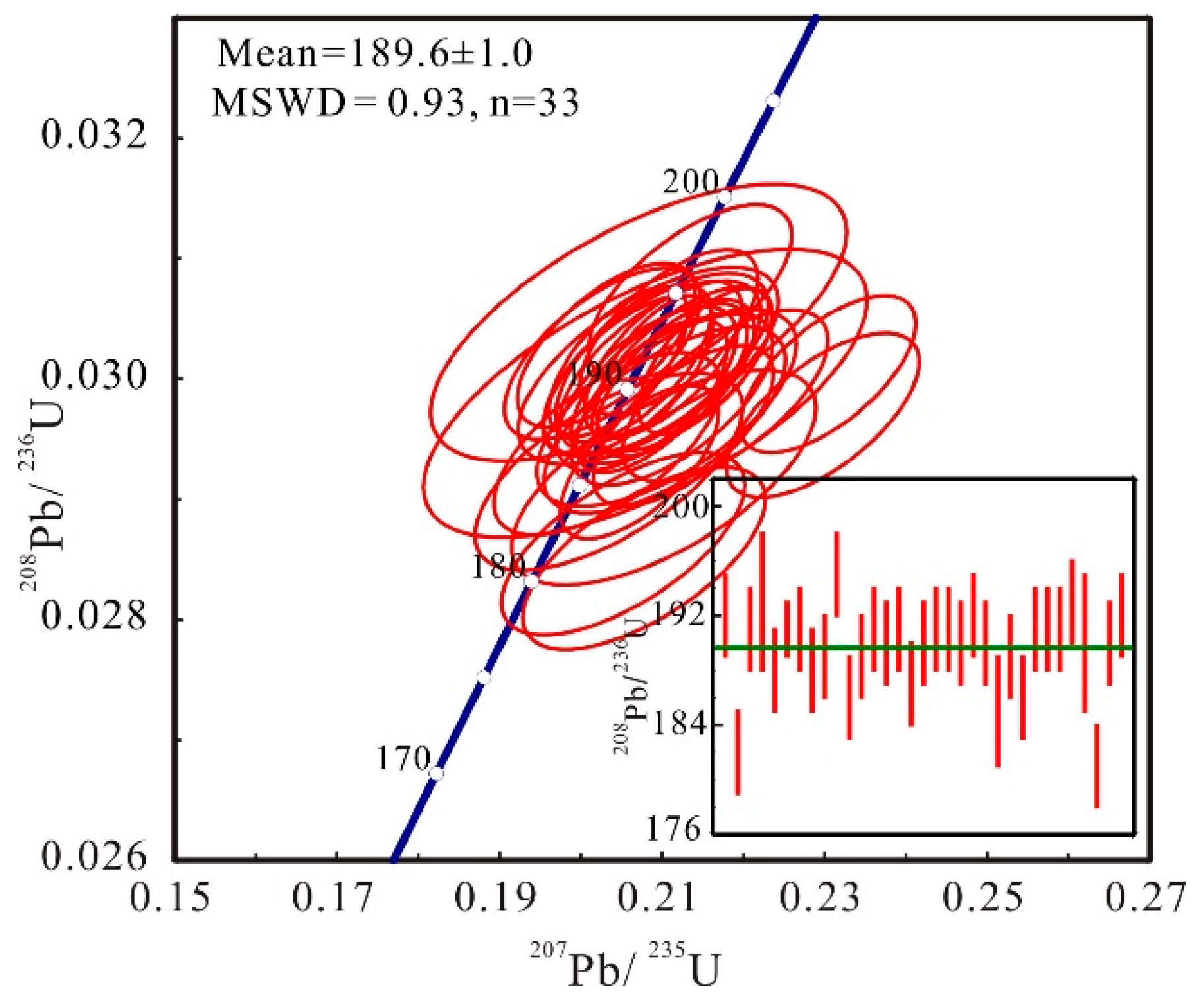
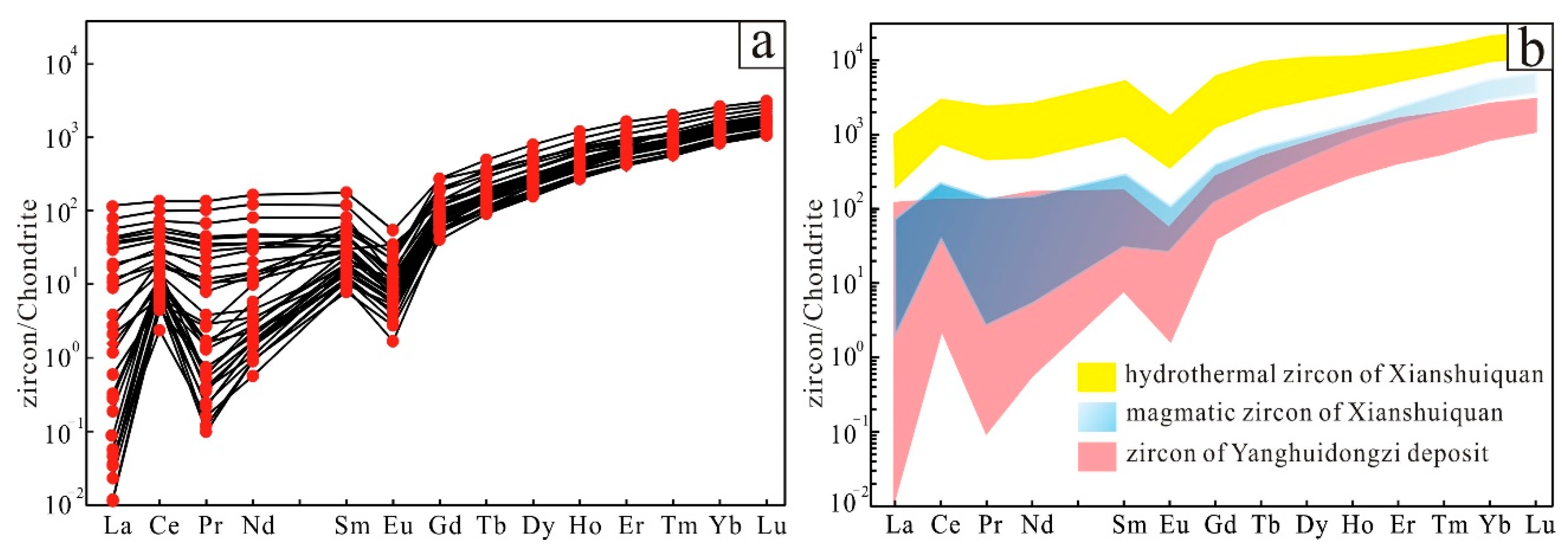
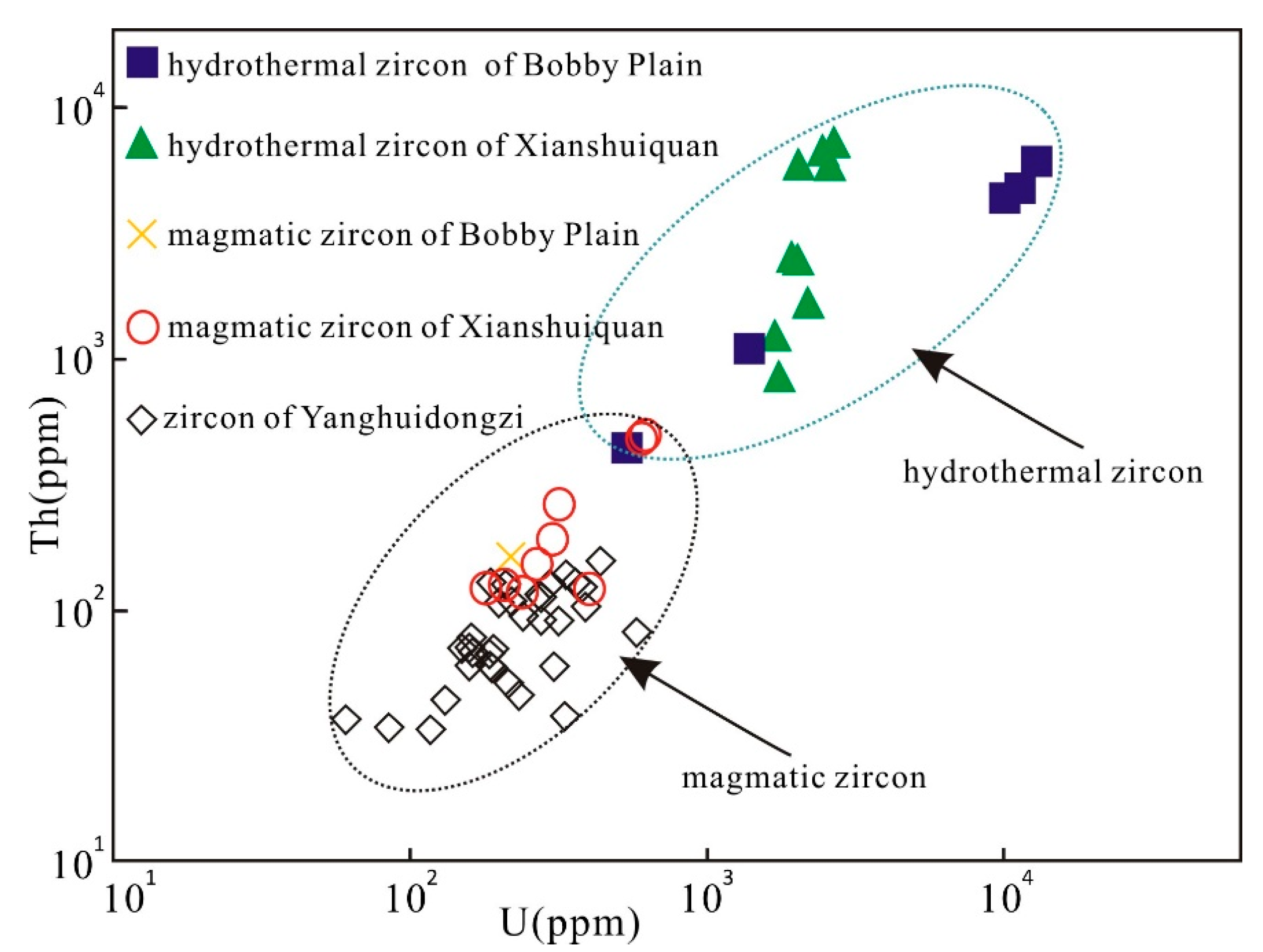
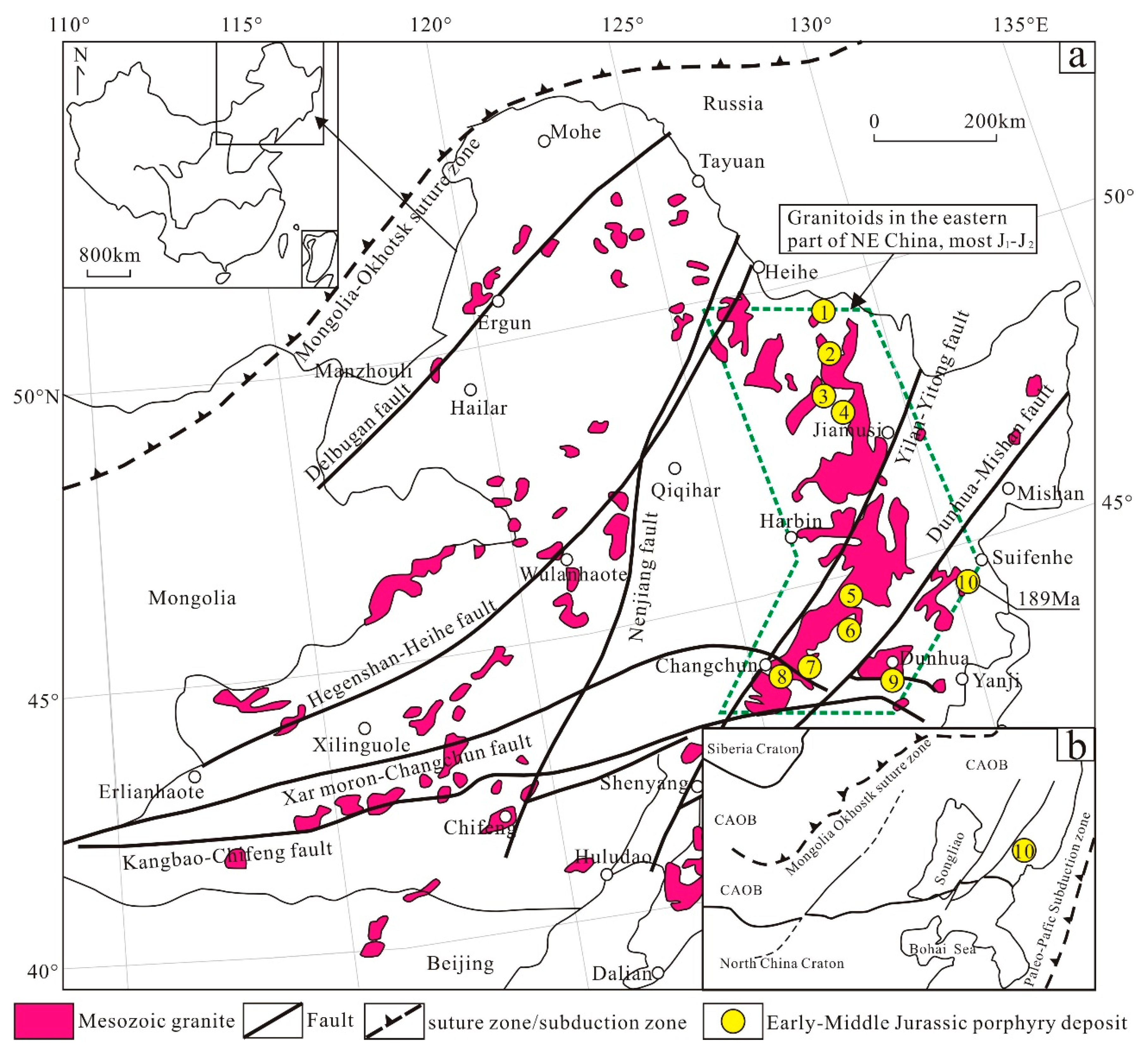
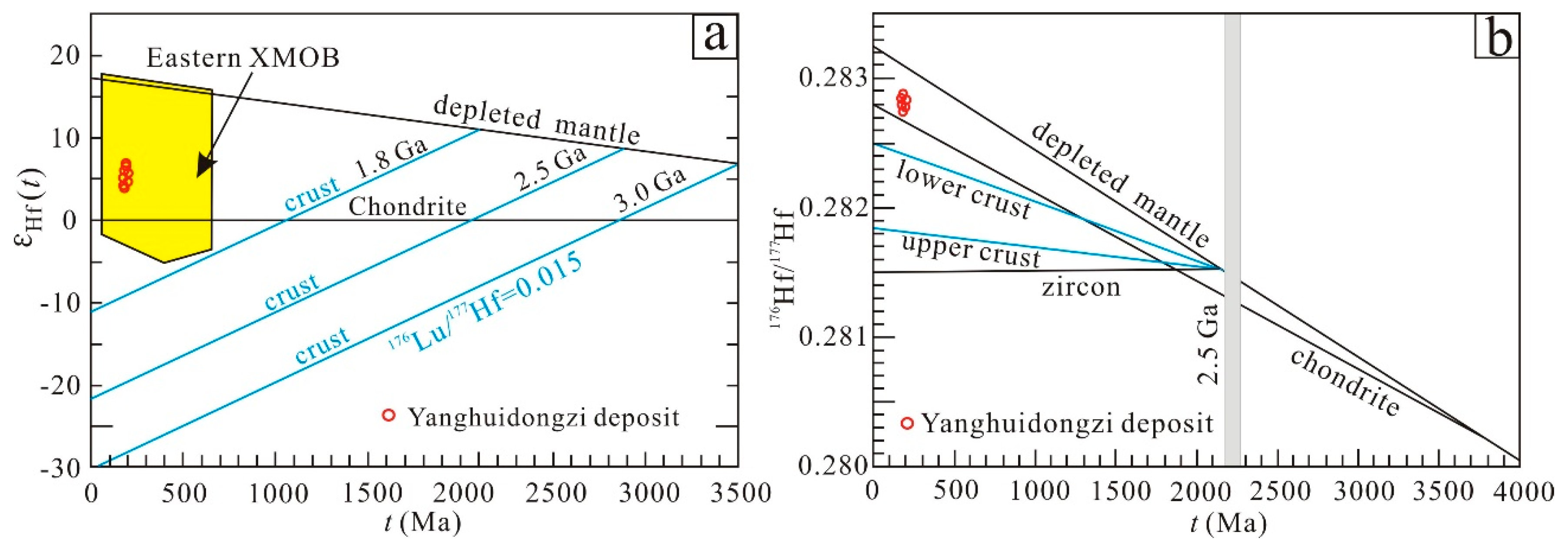
| Spot No. | Th | U | Th/U | U-Th-Pb Isotope Ratio and Error | Age/Ma and Error | ||||||||
|---|---|---|---|---|---|---|---|---|---|---|---|---|---|
| (ppm) | (ppm) | 207Pb/206Pb | 1σ | 207Pb/235U | 1σ | 206Pb/238U | 1σ | 208Pb/232Th | 1σ | 206Pb/238U | 1σ | ||
| YHD-3-01 | 112.77 | 277.75 | 0.41 | 0.04866 | 0.0018 | 0.20314 | 0.0072 | 0.03028 | 0.0005 | 0.00935 | 0.0002 | 192 | 3 |
| YHD-3-02 | 66.97 | 186.41 | 0.36 | 0.05199 | 0.0026 | 0.2052 | 0.0099 | 0.02863 | 0.0005 | 0.00882 | 0.0003 | 182 | 3 |
| YHD-3-03 | 71.07 | 158.93 | 0.45 | 0.05054 | 0.002 | 0.20974 | 0.0082 | 0.0301 | 0.0005 | 0.00961 | 0.0003 | 191 | 3 |
| YHD-3-05 | 43.90 | 131.68 | 0.33 | 0.0493 | 0.0041 | 0.20712 | 0.0169 | 0.03047 | 0.0008 | 0.01077 | 0.0007 | 193 | 5 |
| YHD-3-06 | 77.89 | 162.05 | 0.48 | 0.05144 | 0.0025 | 0.21036 | 0.0098 | 0.02966 | 0.0005 | 0.01046 | 0.0004 | 188 | 3 |
| YHD-3-07 | 81.76 | 583.62 | 0.14 | 0.05037 | 0.0011 | 0.20902 | 0.0047 | 0.0301 | 0.0004 | 0.00978 | 0.0003 | 191 | 2 |
| YHD-3-08 | 91.49 | 278.36 | 0.33 | 0.0497 | 0.0015 | 0.20649 | 0.0063 | 0.03013 | 0.0004 | 0.00937 | 0.0002 | 191 | 3 |
| YHD-3-09 | 90.68 | 318.84 | 0.28 | 0.05207 | 0.0018 | 0.21261 | 0.0073 | 0.02961 | 0.0004 | 0.01046 | 0.0003 | 188 | 3 |
| YHD-3-11 | 51.23 | 215.60 | 0.24 | 0.05611 | 0.0019 | 0.22979 | 0.0078 | 0.0297 | 0.0005 | 0.00946 | 0.0003 | 189 | 3 |
| YHD-3-12 | 67.73 | 163.68 | 0.41 | 0.05039 | 0.002 | 0.21345 | 0.0083 | 0.03072 | 0.0005 | 0.00925 | 0.0003 | 195 | 3 |
| YHD-3-13 | 138.81 | 336.32 | 0.41 | 0.05127 | 0.0016 | 0.2072 | 0.0064 | 0.02931 | 0.0004 | 0.00863 | 0.0002 | 186 | 3 |
| YHD-3-14 | 60.18 | 187.12 | 0.32 | 0.05131 | 0.0026 | 0.21053 | 0.0105 | 0.02976 | 0.0005 | 0.0099 | 0.0004 | 189 | 3 |
| YHD-3-15 | 128.81 | 362.03 | 0.36 | 0.04924 | 0.0014 | 0.20463 | 0.0056 | 0.03014 | 0.0004 | 0.00968 | 0.0002 | 191 | 3 |
| YHD-3-16 | 108.03 | 221.36 | 0.49 | 0.05082 | 0.0018 | 0.21009 | 0.0075 | 0.02998 | 0.0005 | 0.00981 | 0.0003 | 190 | 3 |
| YHD-3-17 | 156.22 | 439.30 | 0.36 | 0.05179 | 0.0013 | 0.2153 | 0.0054 | 0.03015 | 0.0004 | 0.01009 | 0.0002 | 191 | 3 |
| YHD-3-18 | 126.09 | 211.00 | 0.60 | 0.05004 | 0.0023 | 0.20327 | 0.0092 | 0.02946 | 0.0005 | 0.00955 | 0.0003 | 187 | 3 |
| YHD-3-19 | 59.67 | 306.46 | 0.19 | 0.0507 | 0.0015 | 0.20876 | 0.0061 | 0.02986 | 0.0004 | 0.01017 | 0.0003 | 190 | 3 |
| YHD-3-20 | 70.13 | 192.51 | 0.36 | 0.05038 | 0.0022 | 0.20924 | 0.0091 | 0.03012 | 0.0005 | 0.01025 | 0.0004 | 191 | 3 |
| YHD-3-21 | 45.73 | 234.19 | 0.20 | 0.04972 | 0.0017 | 0.20585 | 0.0069 | 0.03003 | 0.0004 | 0.00959 | 0.0003 | 191 | 3 |
| YHD-3-22 | 60.16 | 159.37 | 0.38 | 0.05289 | 0.0021 | 0.21777 | 0.0083 | 0.02986 | 0.0005 | 0.01099 | 0.0003 | 190 | 3 |
| YHD-3-23 | 70.51 | 150.73 | 0.47 | 0.04866 | 0.002 | 0.20268 | 0.008 | 0.03021 | 0.0005 | 0.00916 | 0.0003 | 192 | 3 |
| YHD-3-24 | 115.09 | 273.36 | 0.42 | 0.05043 | 0.0018 | 0.20809 | 0.0073 | 0.02992 | 0.0005 | 0.00933 | 0.0003 | 190 | 3 |
| YHD-3-25 | 128.35 | 188.49 | 0.68 | 0.05224 | 0.0032 | 0.21021 | 0.0124 | 0.02918 | 0.0006 | 0.00923 | 0.0003 | 185 | 4 |
| YHD-3-26 | 106.94 | 200.01 | 0.53 | 0.05136 | 0.002 | 0.21126 | 0.0081 | 0.02983 | 0.0005 | 0.00896 | 0.0003 | 189 | 3 |
| YHD-3-27 | 34.15 | 85.33 | 0.40 | 0.05047 | 0.0028 | 0.20344 | 0.0109 | 0.02923 | 0.0005 | 0.0084 | 0.0004 | 186 | 3 |
| YHD-3-28 | 102.94 | 392.42 | 0.26 | 0.05562 | 0.0018 | 0.23039 | 0.0071 | 0.03004 | 0.0004 | 0.01085 | 0.0003 | 191 | 3 |
| YHD-3-29 | 94.86 | 241.10 | 0.39 | 0.05122 | 0.0018 | 0.21241 | 0.0073 | 0.03008 | 0.0005 | 0.00977 | 0.0003 | 191 | 3 |
| YHD-3-30 | 33.43 | 117.48 | 0.28 | 0.05018 | 0.0026 | 0.20831 | 0.0106 | 0.03011 | 0.0005 | 0.01063 | 0.0005 | 191 | 3 |
| YHD-3-32 | 58.98 | 190.17 | 0.31 | 0.05031 | 0.0018 | 0.21086 | 0.0072 | 0.03039 | 0.0005 | 0.00941 | 0.0003 | 193 | 3 |
| YHD-3-33 | 36.83 | 61.14 | 0.60 | 0.05048 | 0.0045 | 0.20796 | 0.018 | 0.02988 | 0.0008 | 0.01022 | 0.0006 | 190 | 5 |
| YHD-3-34 | 123.07 | 382.65 | 0.32 | 0.05287 | 0.0026 | 0.20779 | 0.0098 | 0.02851 | 0.0005 | 0.00889 | 0.0004 | 181 | 3 |
| YHD-3-36 | 37.92 | 333.64 | 0.11 | 0.05109 | 0.0015 | 0.21124 | 0.0061 | 0.02999 | 0.0004 | 0.0101 | 0.0004 | 190 | 3 |
| YHD-3-38 | 127.17 | 298.07 | 0.43 | 0.05053 | 0.0016 | 0.21012 | 0.0064 | 0.03016 | 0.0004 | 0.00993 | 0.0002 | 192 | 3 |
| Spot No. | La | Ce | Pr | Nd | Sm | Eu | Gd | Tb | Dy | Ho | Er | Tm | Yb | Lu | ΣREE | LREE | HREE | δEu | δCe | (Sm/La)N |
|---|---|---|---|---|---|---|---|---|---|---|---|---|---|---|---|---|---|---|---|---|
| YHD-3-01 | 0.02 | 9.71 | 0.06 | 1.32 | 3.47 | 0.61 | 23.22 | 8.40 | 95.85 | 35.46 | 123.71 | 31.01 | 295.73 | 55.91 | 684.47 | 15.18 | 669.29 | 0.16 | 47.09 | 262.20 |
| YHD-3-02 | 0.37 | 5.76 | 0.15 | 1.06 | 1.52 | 0.31 | 10.42 | 3.67 | 41.98 | 15.56 | 67.57 | 14.24 | 138.92 | 27.25 | 328.79 | 9.18 | 319.61 | 0.17 | 5.89 | 6.35 |
| YHD-3-03 | 0.91 | 8.39 | 0.37 | 2.10 | 2.53 | 0.42 | 13.81 | 4.96 | 54.77 | 19.80 | 82.78 | 16.64 | 159.42 | 30.43 | 397.33 | 14.72 | 382.61 | 0.17 | 3.57 | 4.30 |
| YHD-3-05 | 0.07 | 5.10 | 0.04 | 0.75 | 1.80 | 0.26 | 11.37 | 4.03 | 45.38 | 16.67 | 72.47 | 15.22 | 150.11 | 29.06 | 352.32 | 8.01 | 344.31 | 0.13 | 23.83 | 39.67 |
| YHD-3-06 | 4.47 | 16.57 | 2.09 | 13.76 | 9.62 | 1.49 | 41.56 | 12.67 | 128.07 | 41.48 | 156.10 | 28.88 | 248.73 | 43.67 | 749.16 | 48.00 | 701.16 | 0.19 | 1.32 | 3.33 |
| YHD-3-07 | 0.50 | 3.99 | 0.27 | 1.66 | 1.96 | 0.23 | 13.39 | 5.24 | 65.41 | 24.87 | 113.56 | 25.00 | 251.38 | 48.92 | 556.38 | 8.61 | 547.77 | 0.10 | 2.62 | 6.09 |
| YHD-3-08 | 0.01 | 6.07 | 0.04 | 0.50 | 2.46 | 0.31 | 14.84 | 5.50 | 63.76 | 22.87 | 96.25 | 19.84 | 188.80 | 35.66 | 456.91 | 9.39 | 447.52 | 0.12 | 47.10 | 448.30 |
| YHD-3-09 | 13.57 | 44.67 | 6.40 | 37.68 | 12.38 | 0.75 | 21.61 | 5.75 | 58.00 | 20.04 | 84.74 | 17.09 | 164.76 | 31.47 | 518.91 | 115.45 | 403.46 | 0.14 | 1.17 | 1.41 |
| YHD-3-11 | 2.11 | 10.75 | 1.00 | 5.37 | 3.62 | 0.43 | 15.51 | 5.29 | 59.91 | 21.99 | 95.71 | 20.51 | 199.38 | 38.91 | 480.49 | 23.28 | 457.21 | 0.15 | 1.81 | 2.66 |
| YHD-3-12 | 0.08 | 5.75 | 0.06 | 1.05 | 2.36 | 0.35 | 11.53 | 4.26 | 47.58 | 17.56 | 72.88 | 14.70 | 142.37 | 27.44 | 347.97 | 9.65 | 338.32 | 0.17 | 19.63 | 47.23 |
| YHD-3-13 | 0.01 | 7.10 | 0.03 | 0.79 | 2.59 | 0.40 | 17.30 | 6.30 | 72.95 | 26.77 | 115.26 | 23.93 | 228.09 | 43.68 | 545.20 | 10.92 | 534.28 | 0.14 | 57.12 | 303.94 |
| YHD-3-14 | 6.96 | 24.38 | 2.68 | 14.90 | 5.14 | 0.52 | 16.41 | 5.89 | 66.57 | 24.90 | 110.39 | 23.00 | 221.71 | 44.09 | 567.54 | 54.58 | 512.96 | 0.16 | 1.38 | 1.14 |
| YHD-3-15 | 0.04 | 6.30 | 0.05 | 0.77 | 2.13 | 0.33 | 15.65 | 5.69 | 65.47 | 23.72 | 103.08 | 21.79 | 209.48 | 40.06 | 494.56 | 9.62 | 484.94 | 0.12 | 28.67 | 73.71 |
| YHD-3-16 | 10.34 | 36.21 | 4.25 | 22.33 | 7.19 | 0.73 | 20.74 | 6.37 | 69.92 | 24.82 | 101.67 | 20.42 | 194.77 | 37.17 | 556.93 | 81.05 | 475.88 | 0.17 | 1.34 | 1.08 |
| YHD-3-17 | 0.07 | 7.00 | 0.12 | 1.28 | 4.28 | 0.49 | 27.79 | 10.61 | 119.60 | 43.46 | 182.70 | 37.56 | 341.65 | 62.66 | 839.27 | 13.24 | 826.03 | 0.10 | 14.48 | 100.60 |
| YHD-3-18 | 0.00 | 3.77 | 0.14 | 2.68 | 7.98 | 1.25 | 55.82 | 18.27 | 200.12 | 67.25 | 268.42 | 50.49 | 441.62 | 78.00 | 1195.81 | 15.82 | 1179.99 | 0.13 | 8.59 | 4414.71 |
| YHD-3-19 | 0.01 | 3.30 | 0.01 | 0.42 | 1.79 | 0.18 | 12.82 | 4.93 | 63.84 | 24.00 | 109.12 | 23.72 | 234.16 | 45.28 | 523.58 | 5.71 | 517.87 | 0.09 | 81.01 | 341.36 |
| YHD-3-20 | - | 4.39 | 0.02 | 0.68 | 1.80 | 0.25 | 10.96 | 4.04 | 46.34 | 16.62 | 73.20 | 14.91 | 144.14 | 27.94 | 345.28 | 7.13 | 338.15 | 0.13 | 65.84 | 0.00 |
| YHD-3-21 | 0.01 | 3.17 | 0.02 | 0.44 | 1.21 | 0.16 | 8.31 | 3.38 | 39.57 | 15.25 | 70.22 | 15.31 | 150.10 | 29.34 | 336.49 | 5.01 | 331.48 | 0.11 | 39.05 | 339.94 |
| YHD-3-22 | 8.93 | 28.26 | 3.36 | 16.96 | 4.91 | 0.39 | 13.36 | 3.88 | 46.00 | 16.72 | 71.42 | 14.99 | 143.90 | 28.18 | 401.26 | 62.81 | 338.45 | 0.14 | 1.26 | 0.85 |
| YHD-3-23 | 0.14 | 3.32 | 0.25 | 4.64 | 9.13 | 1.22 | 38.01 | 11.13 | 112.92 | 37.10 | 146.19 | 26.94 | 247.25 | 44.89 | 683.13 | 18.70 | 664.43 | 0.17 | 3.35 | 100.59 |
| YHD-3-24 | 0.28 | 7.18 | 0.16 | 1.56 | 2.87 | 0.39 | 17.92 | 6.70 | 78.11 | 28.77 | 121.33 | 24.45 | 234.54 | 44.57 | 568.84 | 12.45 | 556.39 | 0.13 | 8.11 | 15.88 |
| YHD-3-25 | 8.35 | 27.19 | 3.15 | 16.63 | 6.33 | 0.93 | 23.79 | 7.43 | 80.38 | 27.38 | 110.09 | 21.47 | 195.43 | 35.84 | 564.39 | 62.58 | 501.81 | 0.20 | 1.30 | 1.17 |
| YHD-3-26 | 4.02 | 18.90 | 1.54 | 9.34 | 4.44 | 0.52 | 19.00 | 6.18 | 68.19 | 23.79 | 101.43 | 19.98 | 187.36 | 35.57 | 500.25 | 38.75 | 461.50 | 0.15 | 1.86 | 1.71 |
| YHD-3-27 | 0.01 | 2.76 | 0.07 | 0.92 | 2.87 | 0.72 | 18.42 | 6.44 | 74.98 | 27.37 | 114.25 | 22.52 | 212.21 | 40.22 | 523.75 | 7.34 | 516.41 | 0.23 | 11.92 | 1646.55 |
| YHD-3-28 | 18.55 | 61.08 | 9.70 | 57.06 | 18.16 | 1.75 | 29.00 | 7.43 | 71.89 | 24.20 | 99.59 | 20.59 | 189.43 | 34.87 | 643.30 | 166.30 | 477.00 | 0.23 | 1.11 | 1.52 |
| YHD-3-29 | 9.79 | 32.32 | 3.94 | 20.84 | 6.76 | 0.61 | 18.88 | 6.33 | 69.91 | 24.42 | 105.96 | 20.90 | 208.09 | 38.57 | 567.32 | 74.26 | 493.06 | 0.15 | 1.28 | 1.07 |
| YHD-3-30 | 2.86 | 11.18 | 1.14 | 6.75 | 4.23 | 0.48 | 16.83 | 5.62 | 62.14 | 21.73 | 94.92 | 19.41 | 186.58 | 36.41 | 470.28 | 26.64 | 443.64 | 0.15 | 1.52 | 2.29 |
| YHD-3-32 | 0.01 | 4.68 | 0.01 | 0.42 | 1.67 | 0.26 | 10.59 | 3.61 | 42.77 | 15.93 | 69.68 | 14.51 | 140.07 | 26.83 | 331.04 | 7.05 | 323.99 | 0.14 | 86.94 | 191.05 |
| YHD-3-33 | 27.82 | 82.62 | 12.80 | 76.55 | 27.00 | 3.15 | 55.18 | 13.78 | 128.30 | 39.80 | 152.20 | 28.27 | 256.23 | 47.35 | 951.05 | 229.94 | 721.11 | 0.24 | 1.07 | 1.50 |
| YHD-3-34 | 2.55 | 14.14 | 0.96 | 6.58 | 6.74 | 0.81 | 38.40 | 13.63 | 156.47 | 54.09 | 221.70 | 43.36 | 394.44 | 69.57 | 1023.44 | 31.78 | 991.66 | 0.12 | 2.21 | 4.10 |
| YHD-3-36 | 0.01 | 1.45 | 0.02 | 0.27 | 1.39 | 0.10 | 10.17 | 4.27 | 54.88 | 21.03 | 97.49 | 21.72 | 217.95 | 41.77 | 472.50 | 3.22 | 469.28 | 0.06 | 22.69 | 195.46 |
| YHD-3-38 | 0.65 | 12.72 | 0.75 | 6.05 | 4.55 | 2.02 | 24.60 | 8.61 | 92.84 | 33.20 | 139.20 | 28.32 | 268.31 | 49.52 | 671.34 | 26.74 | 644.60 | 0.47 | 3.89 | 10.83 |
| Spot No. | Age (Ma) | 176Yb/177Hf | 176Lu/177Hf | 176Hf/177Hf | 1σ | εHf(t) | TDM1(Ma) | TDM2(Ma) | fLu/Hf |
|---|---|---|---|---|---|---|---|---|---|
| YHD-3-01 | 192 | 0.016771 | 0.000627 | 0.282800 | 0.000014 | 5.1 | 634 | 904 | −0.98 |
| YHD-3-02 | 182 | 0.014267 | 0.000537 | 0.282812 | 0.000012 | 5.4 | 616 | 882 | −0.98 |
| YHD-3-03 | 191 | 0.017620 | 0.000651 | 0.282830 | 0.000011 | 6.2 | 593 | 838 | −0.98 |
| YHD-3-05 | 193 | 0.015195 | 0.000565 | 0.282823 | 0.000011 | 6.0 | 601 | 851 | −0.98 |
| YHD-3-06 | 188 | 0.024575 | 0.000811 | 0.282816 | 0.000011 | 5.6 | 614 | 871 | −0.98 |
| YHD-3-07 | 191 | 0.015804 | 0.000574 | 0.282816 | 0.000010 | 5.7 | 611 | 868 | −0.98 |
| YHD-3-08 | 191 | 0.016230 | 0.000598 | 0.282798 | 0.000011 | 5.0 | 637 | 910 | −0.98 |
| YHD-3-09 | 188 | 0.014137 | 0.000519 | 0.282827 | 0.000009 | 6.0 | 595 | 846 | −0.98 |
| YHD-3-11 | 189 | 0.014716 | 0.000548 | 0.282818 | 0.000010 | 5.7 | 608 | 866 | −0.98 |
| YHD-3-12 | 195 | 0.012191 | 0.000443 | 0.282842 | 0.000011 | 6.7 | 573 | 807 | −0.99 |
| YHD-3-13 | 186 | 0.018696 | 0.000710 | 0.282802 | 0.000015 | 5.1 | 633 | 904 | −0.98 |
| YHD-3-14 | 189 | 0.018856 | 0.000697 | 0.282803 | 0.000012 | 5.2 | 631 | 899 | −0.98 |
| YHD-3-15 | 191 | 0.017175 | 0.000628 | 0.282808 | 0.000011 | 5.4 | 623 | 886 | −0.98 |
| YHD-3-16 | 190 | 0.020347 | 0.000736 | 0.282815 | 0.000014 | 5.6 | 615 | 873 | −0.98 |
| YHD-3-17 | 191 | 0.021627 | 0.000748 | 0.282837 | 0.000011 | 6.4 | 584 | 822 | −0.98 |
| YHD-3-18 | 187 | 0.034464 | 0.001193 | 0.282842 | 0.000013 | 6.4 | 585 | 818 | −0.96 |
| YHD-3-19 | 190 | 0.013862 | 0.000504 | 0.282845 | 0.000010 | 6.7 | 569 | 803 | −0.98 |
| YHD-3-20 | 191 | 0.015326 | 0.000557 | 0.282792 | 0.000012 | 4.8 | 644 | 922 | −0.98 |
| YHD-3-21 | 191 | 0.012012 | 0.000448 | 0.282794 | 0.000012 | 4.9 | 640 | 918 | −0.99 |
| YHD-3-22 | 190 | 0.020834 | 0.000754 | 0.282829 | 0.000011 | 6.1 | 596 | 842 | −0.98 |
| YHD-3-23 | 192 | 0.019914 | 0.000677 | 0.282829 | 0.000013 | 6.1 | 595 | 840 | −0.98 |
| YHD-3-24 | 190 | 0.012887 | 0.000478 | 0.282838 | 0.000012 | 6.4 | 579 | 819 | −0.99 |
| YHD-3-25 | 185 | 0.020151 | 0.000723 | 0.282837 | 0.000015 | 6.3 | 585 | 827 | −0.98 |
| YHD-3-26 | 189 | 0.019277 | 0.000689 | 0.282828 | 0.000012 | 6.0 | 596 | 843 | −0.98 |
| YHD-3-27 | 186 | 0.021796 | 0.000791 | 0.282788 | 0.000016 | 4.5 | 655 | 937 | −0.98 |
| YHD-3-28 | 191 | 0.013182 | 0.000472 | 0.282837 | 0.000013 | 6.5 | 580 | 819 | −0.99 |
| YHD-3-29 | 191 | 0.013565 | 0.000498 | 0.282854 | 0.000013 | 7.0 | 557 | 783 | −0.99 |
| YHD-3-30 | 191 | 0.018706 | 0.000691 | 0.282819 | 0.000013 | 5.8 | 609 | 863 | −0.98 |
| YHD-3-32 | 193 | 0.013094 | 0.000487 | 0.282826 | 0.000012 | 6.1 | 596 | 844 | −0.99 |
| YHD-3-33 | 190 | 0.023093 | 0.000805 | 0.282840 | 0.000013 | 6.5 | 582 | 818 | −0.98 |
| YHD-3-34 | 181 | 0.022831 | 0.000798 | 0.282786 | 0.000016 | 4.4 | 656 | 943 | −0.98 |
| YHD-3-36 | 190 | 0.017154 | 0.000639 | 0.282790 | 0.000012 | 4.7 | 648 | 928 | −0.98 |
| YHD-3-38 | 192 | 0.027512 | 0.000986 | 0.282833 | 0.000012 | 6.3 | 593 | 832 | −0.97 |
© 2019 by the authors. Licensee MDPI, Basel, Switzerland. This article is an open access article distributed under the terms and conditions of the Creative Commons Attribution (CC BY) license (http://creativecommons.org/licenses/by/4.0/).
Share and Cite
Cong, D.; Pang, H.; Wang, S.; Tian, Y.; Ying, H.; Huang, G. Zircon LA-ICP-MS U-Pb Ages and the Hf Isotopic Composition of the Ore-Bearing Porphyry from the Yanghuidongzi Copper Deposit, Heilongjiang, China, and Its Geological Significance. Minerals 2019, 9, 676. https://doi.org/10.3390/min9110676
Cong D, Pang H, Wang S, Tian Y, Ying H, Huang G. Zircon LA-ICP-MS U-Pb Ages and the Hf Isotopic Composition of the Ore-Bearing Porphyry from the Yanghuidongzi Copper Deposit, Heilongjiang, China, and Its Geological Significance. Minerals. 2019; 9(11):676. https://doi.org/10.3390/min9110676
Chicago/Turabian StyleCong, Diange, Hongli Pang, Shuzhi Wang, Ying Tian, Hui Ying, and Guobiao Huang. 2019. "Zircon LA-ICP-MS U-Pb Ages and the Hf Isotopic Composition of the Ore-Bearing Porphyry from the Yanghuidongzi Copper Deposit, Heilongjiang, China, and Its Geological Significance" Minerals 9, no. 11: 676. https://doi.org/10.3390/min9110676
APA StyleCong, D., Pang, H., Wang, S., Tian, Y., Ying, H., & Huang, G. (2019). Zircon LA-ICP-MS U-Pb Ages and the Hf Isotopic Composition of the Ore-Bearing Porphyry from the Yanghuidongzi Copper Deposit, Heilongjiang, China, and Its Geological Significance. Minerals, 9(11), 676. https://doi.org/10.3390/min9110676




